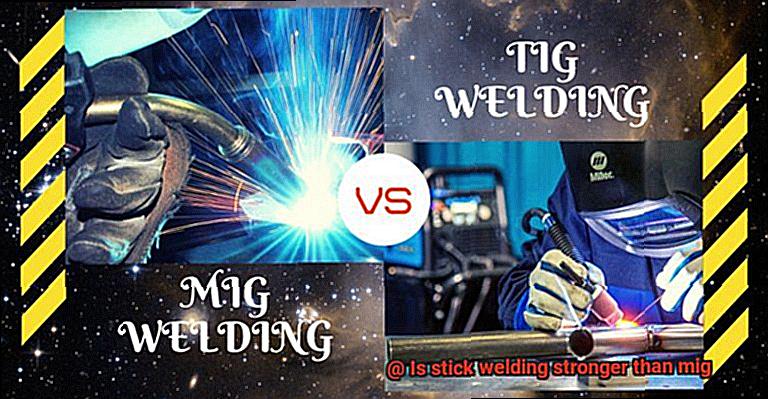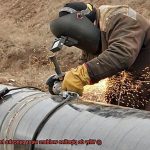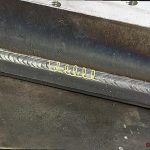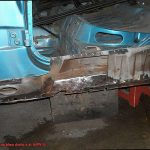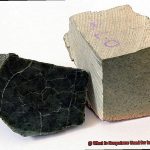Are you wondering if stick welding is stronger than MIG welding? It’s a question that metalworkers have debated for years. Stick welding has long been the go-to method for joining metal parts, but some are concerned that MIG welding isn’t as reliable.
In this blog post, we’ll look at the differences between stick and MIG welding to help you decide which one is best for your project. We’ll discuss the advantages and disadvantages of each in terms of durability, tenacity, cost-effectiveness, and other factors.Plus, we’ll explore how they differ in terms of their applications and what kind of projects they are best suited for.
By the end of this post, you should have a better idea of which type of welding will give you the best potential welds for your specific application. So let’s get started!
What is Stick Welding?
Contents
Stick welding is an arc welding process that utilizes a consumable electrode to create an electrical arc between the electrode and the metal being welded. This arc melts the metal, allowing it to be joined together.
Stick welding is a popular choice for welding outdoors, as it does not require any shielding gas and can be done with a variety of metals.
It’s also relatively easy to learn, making it great for beginners, but requires more skill than other processes such as MIG or TIG welding to produce good welds. Additionally, stick welding produces more spatter and slag which must be cleaned off afterwards.
Advantages of Stick Welding
Stick welding is the perfect solution! It’s a versatile process that can be used to weld many types of metals, including steel, stainless steel, aluminum, cast iron, and more. Plus, it doesn’t require any shielding gas or flux, and the equipment needed is simple and inexpensive compared to other welding processes.
Stick welding is also incredibly portable.
You can take it with you wherever you go, even in remote locations where other welding techniques aren’t available.
And don’t worry about working in tight spaces or on complicated projects; stick welding works in all positions, making it ideal for challenging projects.
Plus, the electrodes used for stick welding are easy to find and relatively affordable compared to other electrode styles. Stick welding offers a great combination of convenience, affordability, and portability, making it the perfect option for joining metals!
What is MIG Welding?
MIG welding might be the right choice for you. Also known as Gas Metal Arc Welding (GMAW), MIG welding is an arc welding process that uses a consumable wire electrode and shielding gas to create a strong weld.
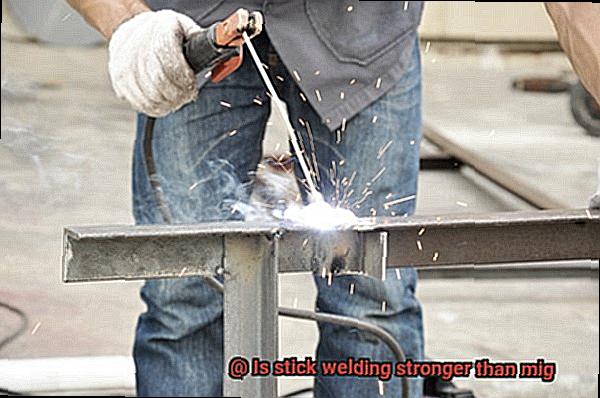
The wire electrode is fed through a welding gun that is connected to an external power source. The shielding gas helps protect the weld from contamination and oxidation, resulting in a strong bond.
MIG welding can be used on many different metals, including aluminum and stainless steel, making it ideal for automotive repair, fabrication, and construction projects.
Plus, it’s relatively easy to learn.
Advantages of MIG Welding
MIG welding is the perfect choice for a variety of projects! It’s faster than stick welding and produces a superior quality weld.
Plus, it can be used on thinner materials because it builds up the weld with filler material. This makes it ideal for those tight spaces where stick welding proves difficult.
And there’s more: MIG welding creates less slag, so there’s less clean up after the weld. Plus, it doesn’t require as much skill as stick welding, making it easier for beginners to learn.
Comparing the Strengths of Stick and MIG Welds
Stick welding is often seen as the most reliable form of welding because it produces a deep, strong, and durable bond. However, it can be harder to use than MIG welding.
MIG welding has a shallower penetration rate than stick welding, which can lead to cracks and other weaknesses. But it has the advantage of being more versatile and easier to use.
Plus, MIG welds are usually faster and require less cleanup than stick welds.
So what should you choose? It really depends on your application and the materials used. Both stick and MIG welds have their advantages and disadvantages that should be carefully weighed before deciding which one is best for your project.
Factors that Affect Strength in Both Types of Welds
Welding is a useful skill to have in your arsenal, but how can you ensure that your welds are as strong as possible? Let’s take a look at some of the factors that affect the strength of stick and MIG welding.
- First, the welder’s skill level has a considerable impact on the weld’s strength. An experienced welder will be able to produce a more robust weld than someone who is less experienced. So if you’re looking for a good welder, make sure to find one with plenty of experience!
- Second, the type of metal being welded also matters. Some metals are much easier to weld than others, and this can have an effect on the final product’s strength. Be sure to take this into account when selecting which metal to use for your project.
- Finally, environmental factors such as wind, humidity, and temperature can all influence how strong a weld is. If you’re welding in an area with high winds or temperatures, extra precautions may need to be taken to ensure your welds are as strong as possible.
Common Uses for Each Type of Weld
Stick and MIG welding are two of the most essential forms of welding used in many industries. Stick welding is ideal for outdoor projects and repairs, such as on vehicles, trailers, and farm equipment. It can also be used in industrial applications.
MIG welding has a wide range of uses, making it suitable for automotive repair and fabrication, production welding of thin materials, home repairs, and construction projects.
Both types of welding can be used to weld steel, aluminum, cast iron, stainless steel, and other metals.
Conclusion
Stick welding and MIG welding are two of the most popular welding methods. Stick welding is often considered to be more robust than MIG, as it uses a thicker rod that can withstand higher temperatures and produces a more stable bond.
On the other hand, MIG welding has its advantages too: it’s faster and simpler to use, requires less maintenance, and can be used on thinner materials. Ultimately, which weld you choose will depend on your application and the materials you’re using.
